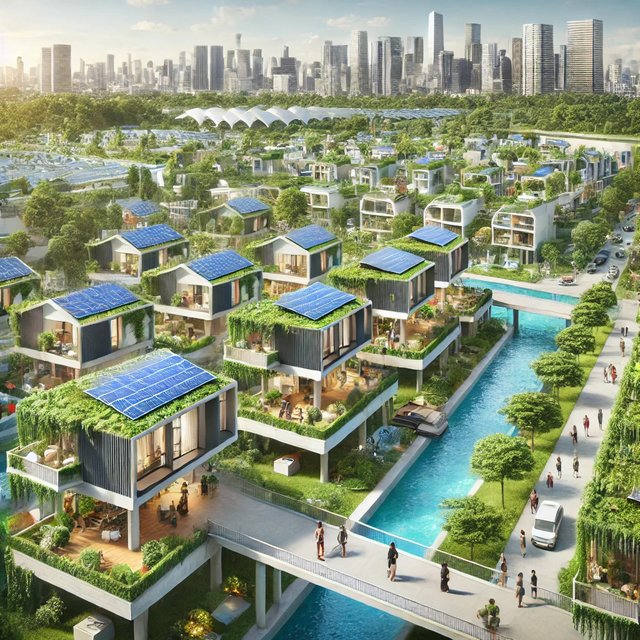Homelessness, Housing, and Heatwaves: Why Climate-Resilient Communities Matter
By: Savoye’ Sharrieff

Imagine trying to sleep on a city bench during a heatwave, the concrete beneath you radiating heat like an oven. Or shivering in drenched clothes after a storm, with nowhere to dry off, nowhere to escape the biting cold. For thousands of people experiencing homelessness, this isn’t just a rough night—it’s their daily reality. And as climate change worsens, their struggle is becoming even more brutal.
Rising temperatures, extreme storms, and natural disasters don’t just make headlines—they destroy lives. The housing crisis has already forced more people onto the streets, and now, with extreme weather events becoming more frequent, many are left completely defenseless against the elements. Without action, more lives will be lost—not just to homelessness, but to the deadly consequences of a changing climate.
To protect those most at risk, we must prioritize affordable housing—not just as an act of compassion, but as a life-saving necessity.

The Role of Civil and Community Engineering in Affordable Housing Solutions
Climate change intensifies the dangers faced by people experiencing homelessness, exposing them to extreme weather conditions. However, through smart civil engineering and community-focused design, we can create affordable housing that is not only safe but also resilient, sustainable, and supportive of long-term stability.
One critical solution is modular construction, which allows for the rapid assembly of prefabricated homes at a fraction of the cost of traditional building methods. These structures can be designed with climate-resilient materials, ensuring durability against extreme weather conditions like hurricanes, floods, and heatwaves. By incorporating solar panels, rainwater collection systems, and energy-efficient insulation, affordable housing can also help reduce utility costs for low-income residents while minimizing environmental impact. Reduction of these costs of homeownership make it less likely that economic changes will result in a person losing their homes.
Beyond shelter, community-centric engineering plays a crucial role in fostering connection and stability. Affordable housing developments should include shared green spaces, community gardens, and multi-use common areas that encourage social interaction and provide a sense of belonging. Research has shown that these features improve mental health, reduce crime rates, and strengthen community resilience in the face of crises.
Additionally, urban planning must focus on strategic placement of affordable housing in areas that offer accessibility to public transportation, job opportunities, and essential services. Instead of isolating low-income communities, integrated development can provide residents with opportunities for upward mobility while reducing their reliance on costly and carbon-heavy transportation.

Addressing the Housing Crisis Through Engineering & Community Design
Climate change isn’t just making homelessness more dangerous—it’s also driving more people into housing instability. In the Greater New Orleans area (GNO), we’ve seen firsthand how extreme weather disrupts lives. Hurricanes, severe flooding, and even rare events like a 10-inch snowfall (January, 2025) can leave already vulnerable individuals without shelter and in crisis conditions. Natural disasters don’t just displace people temporarily; they damage infrastructure, drive up construction costs, and make it harder for low-income families to secure stable housing.
Beyond natural disasters, rising insurance premiums, utility costs, and climate-related damage to real estate are pricing out families who were already on the financial edge. Civil engineers and urban planners must address these challenges through climate-adaptive housing solutions that keep costs low while improving long-term sustainability. This includes:
• Elevated, flood-resistant structures designed to withstand rising water levels.
• Energy-efficient housing with solar and rainwater collection systems to offset rising utility costs.
• Locating affordable housing developments near public transportation and employment hubs to reduce financial strain on residents.
Additionally, climate-resilient community planning can prevent displacement before disasters strike. By integrating emergency shelter spaces into new developments and utilizing storm-resistant building materials, we can create homes that protect residents year-round. The impact of extreme weather is not just a housing crisis—it’s a civil engineering challenge that demands innovative, forward-thinking solutions.

Engineering a Sustainable Future Through Affordable Housing
To combat this growing crisis, we must prioritize investment in climate-resilient, affordable housing that integrates innovative engineering solutions. Safe and stable housing is not just about providing shelter—it’s about building structures that protect residents from extreme weather events while fostering long-term economic and environmental sustainability. Engineers, urban planners, and community developers have a critical role to play in designing homes that mitigate climate risks, lower long-term costs, and strengthen communities.
Strategic investments in green, high-efficiency housing can provide long-term solutions that serve both the people and the planet. This includes:
• Resilient building materials, such as hurricane-rated windows, flood-resistant foundations, and fire-retardant insulation, to withstand climate extremes.
• Sustainable energy systems, like solar power, rainwater collection, and passive cooling designs, to reduce residents' utility expenses while decreasing environmental impact.
• Smart community planning, ensuring that affordable housing developments are located near essential services, job centers, and reliable public transportation, reducing the financial burden on residents.
Beyond simply being a humane solution, investing in climate-conscious, community-driven housing also reduces the strain on emergency services, hospitals, and shelters—ultimately saving public funds. By embracing sustainable, well-planned developments, we can build stronger, more resilient communities that offer stability, security, and opportunity for all.

A Call to Action for Resilient, Affordable Housing
Climate change is no longer a distant threat—it’s an immediate crisis, especially for those experiencing homelessness. With extreme weather events intensifying and rising housing costs displacing more individuals, the need for sustainable, affordable housing has never been greater. If we fail to act, hundreds of thousands more will be left vulnerable to life-threatening conditions with no path to stability.
The solution is clear: strategic investment in resilient, community-focused housing that not only shelters but protects. By integrating climate-conscious design, durable infrastructure, and accessible urban planning, we can create communities that are not only affordable but also built to withstand environmental challenges. This isn’t just about providing homes—it’s about engineering long-term stability, reducing public costs, and ensuring that no one is left unprotected as climate risks escalate.
The time to act is now. By prioritizing sustainable, affordable housing, we can build a future where safety, security, and resilience are not privileges—but guarantees for all.

Additional Resources and Works Cited
- Climate Change and Homelessness
Source: Ramin, B., & Svoboda, T. (2009). Health of the Homeless and Climate Change. Journal of Urban Health, 86(4), 654–664.
Summary: This study examines how climate change exacerbates health risks among homeless populations, highlighting increased exposure to extreme weather events and the resulting health complications. - Engineering Methods for Affordable Housing
Source: National Research Council. (2003). Engineering Methods for Planning Affordable Housing and Infrastructure. In Proceedings of the National Conference on Housing and Urban Development Issues (pp. 150-165).
Summary: This paper discusses innovative engineering and construction methods aimed at developing affordable housing, emphasizing the role of urban planning and sustainable design. - Barriers to Affordable Housing Construction
Source: Amoah, P., & Simpeh, F. (2023). Barriers to and Enablers of Affordable Housing Construction: Insights from Upstate New York. Buildings, 13(2), 345.
Summary: This research identifies challenges and facilitators in affordable housing construction, providing insights into effective strategies for stakeholders in the housing sector. - Climate Change Impacts on Homelessness
Source: Cusack, L., van Loon, A., Kralik, D., Arbon, P., & Gilbert, S. (2013). Extreme-weather-related health needs of people who are homeless. Australian Journal of Primary Health, 19(3), 250–255.
Summary: The study explores the health impacts of extreme weather on homeless individuals, emphasizing the need for targeted interventions to protect this vulnerable population. - Sustainable Low-Cost Housing
Source: Sivakrishna, A., & Senthilkumar, R. (2022). A state-of-the-art review on sustainable low-cost housing and infrastructure. Materials Today: Proceedings, 62(1), 311–315.
Summary: This article reviews sustainable materials and construction techniques for low-cost housing, proposing innovative solutions to address housing affordability and environmental sustainability.